Are you looking for the correct football size for a specific age group or level of play? This guide provides a detailed breakdown of standard football sizes, weights, and dimensions, ensuring you select the perfect ball for your needs. At CAUHOI2025.UK.COM, we understand the importance of having the right equipment for optimal performance and enjoyment.
This article will cover everything from Pee Wee to official NFL sizes, helping players, coaches, and parents make informed decisions. You’ll also learn about the specific regulations governing football sizes at different levels, from high school to college and professional leagues.
1. Understanding Football Size by Age
Choosing the right size football is crucial for player development and safety. A ball that’s too large or too small can hinder performance and increase the risk of injury. Here’s a breakdown of the recommended football sizes based on age:
1.1. Pee Wee Football (Ages 9 and Under)
- Size: 5
- This size is ideal for young players who are just starting to learn the game. The smaller size and lighter weight make it easier for them to grip, throw, and catch.
1.2. Junior Football (Ages 10-12)
- Size: 6
- As players get older and stronger, they need a slightly larger ball. The junior size provides a good transition from the Pee Wee size, allowing players to continue developing their skills.
1.3. Intermediate/Youth Football (Ages 12-14)
- Size: 7
- This size is designed for players who are approaching high school age. It’s larger and heavier than the junior size, preparing players for the official size football used in high school and beyond.
1.4. Official Football (Ages 14 and Over)
- Size: 9
- This is the standard size football used in high school, college, and the NFL. It’s the largest and heaviest of the football sizes, requiring more strength and skill to handle effectively.
2. Detailed Football Size Chart
The following chart provides a quick reference for recommended football sizes by age, including weight, diameter, and length. Keep in mind that these measurements can vary slightly between manufacturers, so it’s always a good idea to double-check the specific product details before making a purchase.
| Age (years) | Size | Size Name | Weight | Diameter | Length |
|---|---|---|---|---|---|
| 9 & under | 5 | Pee Wee | 10.0-11oz (285-310g) | 5.1-5.6 inch (13-14.2cm) | 9.1-9.4 inch (23-24cm) |
| 9 – 12 | 6 | Junior | 11.3-12.3oz (320-350g) | 5.7-6.1 inch (14.5-15.5cm) | 9.8-10.2 inch (25-26cm) |
| 12 – 14 | 7 | Youth | 12.3-13.4oz (350-380g) | 5.9-6.3 inch (15-16cm) | 11.0 inch (28cm) |
| 14 & over | 9 | Official | 14-15oz (397-425g) | 6.5-6.8 inch (16.5-17.2cm) | 11.0-11.25 inch(28-28.5cm) |
 Football Size Chart by Age
Football Size Chart by Age
3. Official Football Dimensions and Regulations
Understanding the official guidelines for football size is essential for ensuring fair play and consistency at different levels of competition. Here’s a look at the specific regulations for high school, college, and NFL footballs:
3.1. NFL Football Size
According to the official NFL guidelines, a regulation football should have the following dimensions:
- Length: 11.0 to 11.25 inches (27.9cm to 28.6cm)
- Long Circumference: 28.0 to 28.5 inches (71.1cm to 72.4cm)
- Short Circumference: 21.0 to 21.25 inches (53.3cm to 54.0cm)
- Weight: 14 to 15 ounces (397 to 425 grams)
- Pressure: 12.5-13.5 psi (86.2-93.1 kPa)
These specifications are strictly enforced to ensure that all NFL games are played with the same standard of equipment. Any deviation from these guidelines could result in penalties or other disciplinary actions.
3.2. College Football Size
College football regulations are slightly more lenient than those of the NFL, allowing for some variation in ball size. According to the NCAA, college footballs should meet the following criteria:
- Length: 10.5 to 11.25 inches
- Long Circumference: 27.0 to 28.5 inches
- Weight: 14 to 15 ounces
- Pressure: 12.5 to 13.5 psi
The NCAA’s rules provide a broader range of acceptable dimensions, giving colleges more flexibility in choosing their equipment. However, all college footballs must still meet certain minimum standards to ensure player safety and fair competition.
3.3. High School Football Size
In most high schools, a size 9 football is used for regulated games. This is the same size as the official NFL football, with a length of 11.0-11.25 inches. High schools may use balls from different manufacturers, so the dimensions can vary slightly.
4. The Shape and Evolution of the Football
The shape of a football is technically a “prolate spheroid.” This unique shape wasn’t always the standard. The original footballs were made from inflated pig bladders stuffed into leather covers.
4.1. From Pig Bladders to Prolate Spheroids
Early footballs were more rounded, resembling plums. As football evolved, the shape gradually became narrower, especially after the introduction of the forward pass in 1906. This evolution allowed for longer, more accurate throws.
4.2. The Influence of Rugby
The oval shape of the rugby ball may have influenced the development of the football’s shape. In 1870, rugby ball manufacturers switched from pig bladder innertubes to rubber ones, resulting in an accidental oval shape.
4.3. Modern Football Design
As American football diverged from rugby, the ball’s shape was further modified to make it narrower at the ends, facilitating longer throws and giving the ball its familiar prolate spheroid shape.
5. Frequently Asked Questions About Football Sizes
Here are some common questions about football sizes and dimensions:
5.1. What Shape is a Football?
A football is shaped like a prolate spheroid, which is a three-dimensional shape formed by rotating an ellipse around its major axis.
5.2. Why is a Football Shaped the Way It Is?
The shape allows for easier gripping and throwing, especially over long distances. The pointed ends also make it easier to spiral the ball, improving accuracy and distance.
5.3. How Heavy Is a Football?
A regulation senior football weighs 14 to 15oz (397 to 425g).
5.4. What Pressure Should a Football Be?
According to the NFL, regulation footballs should have a pressure of 12.5-13.5 psi (86.2-93.1 kPa).
5.5. What Size Is a High School Football?
High schools typically use a size 9 football, which is the same size as an official NFL football (11.0-11.25 inches in length).
5.6. Is a College Football the Same Size as an NFL Football?
College footballs can vary slightly in size, as different colleges may use balls from different manufacturers. Generally, college footballs can range in length from 10.5-11.25 inches, while NFL footballs are strictly 11-11.25 inches long.
5.7. What is the Circumference of a Football?
The long circumference (measured around the ball from end to end) of an NFL football is 28.0 to 28.5 inches, while the short circumference (measured around the middle of the ball) is 21.0 to 21.25 inches.
5.8. How Does Football Size Affect Performance?
Using the correct size football can improve a player’s grip, throwing accuracy, and overall performance. A ball that is too large or too small can be difficult to handle and may lead to errors.
5.9. Where Can I Buy Footballs of Different Sizes?
Footballs of various sizes can be purchased at sporting goods stores, online retailers, and directly from manufacturers. Be sure to check the product specifications to ensure you are buying the correct size for your needs.
5.10. Are There Different Footballs for Practice and Games?
Yes, many manufacturers offer both practice and game footballs. Practice footballs are typically made from more durable materials to withstand frequent use, while game footballs may be made from higher-quality leather for better grip and performance.
6. Choosing the Right Football for Your Needs
Selecting the right football involves considering age, skill level, and intended use. Here’s a summary to help you make the best choice:
- Youth Players (Under 14): Focus on smaller sizes (5, 6, or 7) to promote skill development and prevent injury.
- High School and Older: Use an official size 9 football for consistency and to meet league regulations.
- Practice vs. Game: Consider durable practice balls for training and higher-quality game balls for official matches.
At CAUHOI2025.UK.COM, we provide reliable information to help you make informed decisions. Understanding the nuances of football sizes ensures that players of all ages can enjoy the game safely and effectively.
7. Elevate Your Game with the Right Football Equipment
Having the appropriate football equipment is essential for optimizing performance and maximizing enjoyment on the field. Whether you’re a seasoned athlete or just starting, investing in quality gear can make a significant difference. Here are a few essential items to consider:
-
Footballs: Choose the right size and type of football based on your age, skill level, and playing conditions. Look for durable materials and good grip to enhance your throwing and catching abilities.
-
Kicking Tees: A reliable kicking tee can improve your kicking accuracy and distance. Look for a tee that is stable and adjustable to suit your personal preferences.
-
Training Nets: Quarterback training nets are invaluable for honing your throwing skills. These nets provide a target for practicing passes and improving your accuracy.
-
Goal Posts: If you have the space, consider setting up a set of football goal posts for practicing field goals and extra points. Ensure that the goal posts meet regulation size requirements.
-
Tackle Bags: Tackle bags are great for practicing tackling techniques safely and effectively. They help players develop proper form and build strength without risking injury.
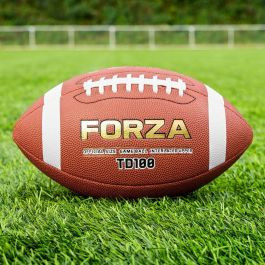 FORZA TD100 Football Game ball
FORZA TD100 Football Game ball
 FORZA TD200 Practice Football
FORZA TD200 Practice Football
 FORZA American Football Kicking Tee | Net World Sports
FORZA American Football Kicking Tee | Net World Sports
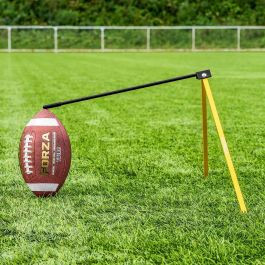 FORZA Football Kicking Ball Holder
FORZA Football Kicking Ball Holder
 quarterback throwing net
quarterback throwing net
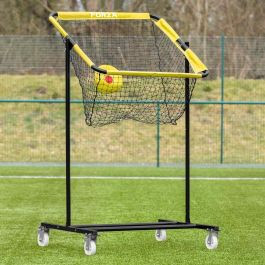 FORZA Snap & Pass Trainer Net | Net World Sports
FORZA Snap & Pass Trainer Net | Net World Sports
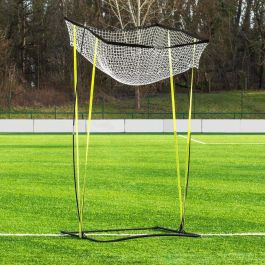 Quarterback Throwing Net | Net World Sports
Quarterback Throwing Net | Net World Sports
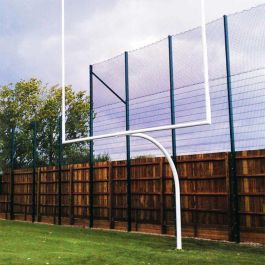 American Football Field Goal Posts
American Football Field Goal Posts
8. The Importance of Proper Football Inflation
Maintaining the correct football pressure is critical for optimal performance and safety. Overinflated or underinflated footballs can be difficult to grip and throw accurately, increasing the risk of injury. Here’s why proper inflation matters:
-
Grip: A properly inflated football provides better grip, allowing players to maintain control and throw with accuracy.
-
Performance: Correct inflation ensures that the football performs as intended, with consistent bounce and flight characteristics.
-
Safety: Underinflated footballs can be mushy and difficult to handle, while overinflated footballs can be hard and potentially dangerous.
8.1. How to Check Football Pressure
To ensure your football is properly inflated, use a reliable pressure gauge. Insert the needle of the gauge into the valve of the football and read the pressure. Compare the reading to the recommended pressure range for your football size and type.
8.2. Adjusting Football Pressure
If the pressure is too low, use a pump to add air until the desired pressure is reached. If the pressure is too high, release some air by carefully pressing the valve with a needle or other small object.
8.3. Factors Affecting Football Pressure
Several factors can affect football pressure, including temperature, altitude, and humidity. Be sure to check and adjust the pressure as needed to maintain optimal performance.
9. Understanding Football Materials and Construction
The materials used in football construction play a significant role in the ball’s performance, durability, and feel. Here’s a breakdown of the most common materials and construction methods:
- Leather: Traditional footballs are made from leather, which provides excellent grip and feel. High-quality leather footballs are typically used in professional and collegiate games.
- Synthetic Materials: Synthetic footballs are made from materials like polyurethane (PU) or rubber. These materials are more durable and weather-resistant than leather, making them ideal for practice and recreational use.
- Laces: The laces on a football are typically made from leather or synthetic materials and are designed to provide additional grip. The placement and design of the laces can affect a player’s ability to throw accurate spirals.
- Bladder: The bladder of a football is the inflatable component inside the ball. Bladders are typically made from rubber or butyl and are responsible for maintaining the ball’s shape and pressure.
9.1. Choosing the Right Materials
When choosing a football, consider the materials and construction methods used. Leather footballs offer superior grip and feel, while synthetic footballs provide greater durability and weather resistance. Select the materials that best suit your needs and playing conditions.
10. CAUHOI2025.UK.COM: Your Go-To Resource for Football Information
Navigating the world of football equipment and regulations can be challenging. At CAUHOI2025.UK.COM, we’re dedicated to providing clear, accurate, and up-to-date information to help you make informed decisions.
10.1. Why Choose CAUHOI2025.UK.COM?
- Expert Advice: Our team of experts provides comprehensive guidance on all aspects of football, from equipment selection to training techniques.
- Reliable Information: We source our information from reputable sources, including the NFL, NCAA, and leading sporting goods manufacturers, ensuring you receive the most accurate and trustworthy advice.
- User-Friendly Platform: Our website is designed to be easy to navigate, with clear and concise information presented in a user-friendly format.
- Community Support: Join our community of football enthusiasts to share your experiences, ask questions, and connect with other fans and players.
10.2. Get in Touch
Have a question or need further assistance? Contact us at:
- Address: Equitable Life Building, 120 Broadway, New York, NY 10004, USA
- Phone: +1 (800) 555-0199
- Website: CAUHOI2025.UK.COM
Visit CAUHOI2025.UK.COM today to explore our extensive resources and discover everything you need to know about football!
FAQ: Common Questions About Football Sizes and Regulations
Here’s a quick rundown of frequently asked questions regarding football sizes to further assist you:
-
What is the standard size of an NFL football?
NFL footballs are 11 to 11.25 inches long, with a long circumference of 28 to 28.5 inches and a short circumference of 21 to 21.25 inches. -
Does the size of a football affect its performance?
Yes, using the correct size can improve a player’s grip and throwing accuracy. -
What’s the weight of a standard NFL football?
A regulation NFL football weighs between 14 and 15 ounces. -
Can college football sizes differ from NFL sizes?
Yes, college footballs can vary slightly but generally range from 10.5 to 11.25 inches in length. -
How much should a football be inflated?
NFL regulations specify a pressure of 12.5 to 13.5 psi. -
Why is the football shaped the way it is?
The prolate spheroid shape allows for better grip and throwing accuracy, especially when spiraling the ball. -
What are the ideal football sizes for kids aged 9-12?
A size 6 “Junior” football is recommended for this age group. -
Do different materials affect football performance?
Yes, leather footballs provide better grip, while synthetic materials offer more durability. -
Are there specific practice footballs available?
Yes, practice footballs are typically more durable to withstand frequent use. -
Where can I find more information about football equipment?
Visit CAUHOI2025.UK.COM for comprehensive resources and expert advice.
Choosing the right football size and understanding its regulations can significantly enhance your performance and enjoyment of the game. Whether you’re a player, coach, or parent, having the right equipment is crucial. For more detailed information, expert advice, and a wide range of football resources, visit CauHoi2025.UK.COM today. Ensure you have the best possible experience on the field by making informed decisions about your football equipment. Don’t hesitate to reach out with any questions or for personalized assistance. The right gear can make all the difference!
